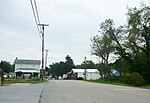Volkswagen Westmoreland Assembly was a manufacturing complex located 35 miles (56 km) southeast of Pittsburgh in Westmoreland County, Pennsylvania, near New Stanton — and noted for manufacturing 1.15 million Volkswagens from 1978 until 1987. When VWoA began manufacturing in the unfinished Chrysler plant, it became the first foreign automobile company to build cars in the US since Rolls-Royce manufactured cars in Springfield, Massachusetts, from 1921 to 1931.Chrysler had called the facility the New Stanton plant; Volkswagen changed the name to Westmoreland.The factory manufactured a range of fuel-efficient small cars with gasoline and diesel engines, all variants (or rebadged models) of Volkswagen's Golf: the Rabbit (79–84); Rabbit GTI (83–84); Rabbit Pickup (1979–1982); the Golf Mk2 and GTI (85–89) and the Jetta (87–89). Built with the largest incentive package the Commonwealth of Pennsylvania had ever offered, the factory had an estimated annual capacity of 240,000 cars, and reached production of 200,000 in 1980. Engines and drivetrains for Westmoreland production were sourced from Germany. Employment, projected at 20,000, reached its highest level in mid-1981 at 6,000 and by 1984 had dropped to 1,500.Initially the plant was successful, but numerous factors contributed to a sharp decline in sales of the cars manufactured at Westmoreland and the factory's ultimate demise. Increased competition in the North American small car market, easing of the period's fuel crisis, poorly received changes to the character of the cars, VWoA's long product life-cycle, the internal economics of the plant, persistent labor unrest and poor networking between Westmoreland and Volkswagen headquarters in Germany. The factory operated at less than half its design capacity and VWoA suffered operating losses during the last five years of its operation. Sales of Volkswagen's US-built cars plummeted by nearly 60% between 1980 and 1985.Japanese manufacturers soon followed VWoA's presence in the US – achieving success but having non-unionized plants including Honda at their Marysville, Ohio, plant and Toyota at their Georgetown, Kentucky, plant.By the early 1980s, Volkswagen began retreating from manufacturing in North America, selling another assembly plant it had begun developing and two ancillary plants to Westmoreland in West Virginia and Texas. With the plant operating at 40% capacity and annual losses of $120 million, Volkswagen closed Westmoreland Assembly on July 14, 1988.Volkswagen later expanded production of cars in Puebla, Mexico, and in 2011 inaugurated its Chattanooga Assembly Plant.
The Westmoreland plant was subsequently used by Sony in the production of televisions from 1990 to 2008, as the Sony Technology Center-Pittsburgh (STCP). As of 2014, the site is marketed as RIDC Westmoreland and is owned by RIDC, the Regional Industrial Development Corporation of Southwestern Pennsylvania.



